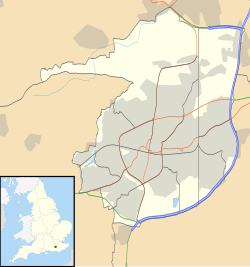St John the Baptist's Church, Crawley
| St John the Baptist, Crawley | |
|---|---|

The church from the southeast
|
|
| 51°6′50″N 0°11′19″W / 51.11389°N 0.18861°WCoordinates: 51°6′50″N 0°11′19″W / 51.11389°N 0.18861°W | |
| Denomination | Church of England |
| Churchmanship | Modern Catholic |
| History | |
| Dedication | John the Baptist |
| Administration | |
| Parish | Crawley, St John the Baptist |
| Deanery | East Grinstead |
| Archdeaconry | Horsham |
| Diocese | Chichester |
| Province | Canterbury |
| Clergy | |
| Priest(s) | Rev. Malcolm Liles |
St John the Baptist's Church is an Anglican church in Crawley, a town and borough in West Sussex, England. It is the parish church of Crawley, and is the oldest building in the town centre, dating from the 13th century—although many alterations have been made since, and only one wall remains of the ancient building.
In the Norman era, Slaugham and Cuckfield were the most important places in the north of the county of Sussex. When Crawley first started to develop as a village in the 13th century, it was in the parish of Slaugham in the Hundred of Buttinghill (hundreds were ancient divisions of land covering several parishes). As the new village was distant from the parish church at Slaugham (St Mary's), several miles south, a stone church was built as a chapel of ease. It is known to have existed before 1267, when it was passed on in a will, and it was still the daughter church of Slaugham in 1291; but by the early 15th century it was referred to as a "free" church and a "permanent chantry". The parish of Crawley was therefore established separate from Slaugham at some point, probably by the end of the 14th century, and St John the Baptist's was regarded as its parish church by the time chantries were abolished in the 1540s. Crawley was a small, very narrow, split parish, and did not cover the whole of the village of Crawley: the boundary between it and the parish of Ifield—and between the Hundred of Buttinghill and the Hundred of Burbeach, in which Ifield lay—ran up the middle of the High Street. The detached part of Crawley parish consisted of heavily forested land and one farm near Pease Pottage. The total area of the parish was less than 800 acres (300 ha); Ifield parish was six times larger, in contrast.
...
Wikipedia

